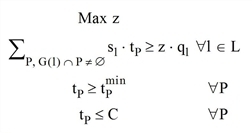For pure split optimization, the cycle time is considered to be fixed.
|
Note: For nodes (main nodes) of the signal controller to be optimized, an ICA calculation is performed as part of the optimization. We recommend to execute the network check function Viability for ICA for these nodes (main nodes). |
Green time optimization for signal group-based signal programs (Vissig)
A signal group-based signal program must be set for the signal controller. The optimization of signal group-based signal programs is traced back to the procedure of stage-based programs and can be described simplified by the following three steps:
1. Internal stages are generated from the current green times of the signal groups.
Visum first defines set T of all switching points from the attributes Green time start and Green time end of all signal groups and sorts these in ascending order. For each interval between consecutive times ti and ti+1 in T a stage is generated containing all signal groups available during [ti ; ti+1).
2. Optimization is performed as for stage-based programs (Green time optimization for stage-based signal programs (Vissig)).
3. The green times of the signal groups are determined from the optimal green times of the stages, i.e. the green time of each signal group results from the green times of all stages containing the signal group.
Green time optimization for signal group-based programs in which signal groups have a second green time is not possible.
Green time optimization for stage-based signal programs (Vissig)
Stages must be defined for the signal controller and a stage-based signal program must be set. If you want to exclude individual stages from the optimization and retain their length from the original signal program, set their Pseudo stage attribute to true. This change must be made in the Vissig window.
Visum executes the following steps to calculate the green time split:
1. Execute an ICA calculation and determine both saturation flow rate and volume for each lane group. This results in:
-
The division of approaches into lane groups.
-
The adjusted volume v for each lane group.
-
The saturation flow rate s for each lane group.
-
The critical lane group for each stage.
2. Solve the linear optimization problem:

where
|
L |
set of all lane groups |
|
C |
cycle time |
|
sl |
saturation flow rate of lane group l |
|
ql |
volume of lane group l |
|
tP |
green time duration of stage P |
|
|
Minimum duration of stage P |
The first of the three constraints expresses that the share z of the volume of each lane group can be served by the green times of the stages available for that group. The objective function states that this share z is maximized.
The second constraint expresses that the duration of a stage is greater than its minimum duration. The minimum duration of a stage also considers compliance with the minimum green times of the signal groups it contains.
The third constraint says that the green time of the stage must be smaller than the cycle time.
3. An ICA calculation is performed again for the optimized signal program.
4. If the total mean wait time has not improved, Visum terminates and step 5 is carried out. If the saturation flow rates have changed, the program proceeds with 2 , if not, step 5.
5. Assign the Green time start and Green time end attributes of the stages the values of the latest optimum solution.


